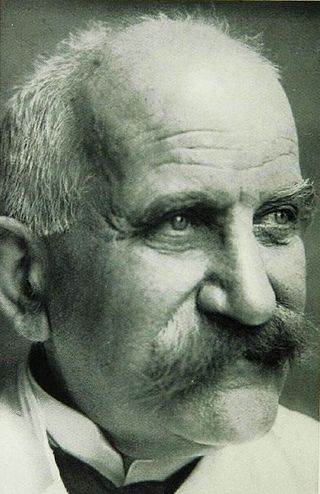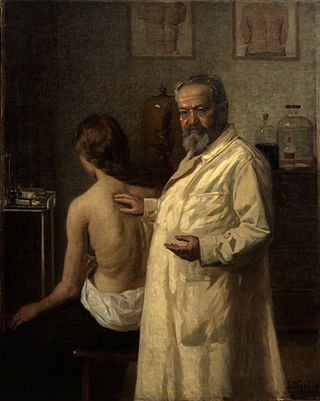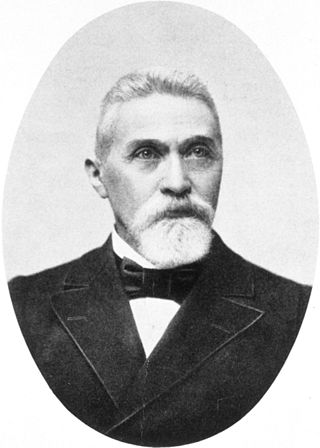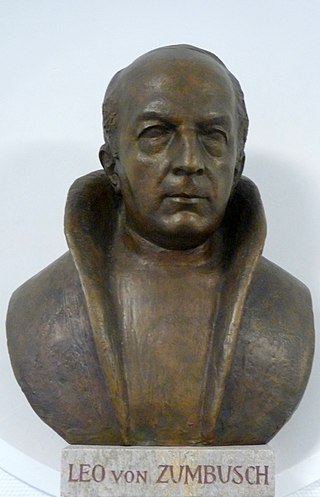
Carl Heinrich Auspitz was a Jewish Austrian dermatologist. He was the husband of pianist Auguste Auspitz-Kólar (1843–1878).

Rhinoscleroma, is a chronic granulomatous bacterial disease of the nose that can sometimes infect the upper respiratory tract. It most commonly affects the nasal cavity—the nose is involved in 95–100 per cent of cases—however, it can also affect the nasopharynx, larynx, trachea, and bronchi. Slightly more females than males are affected and patients are usually 10 to 30 years of age. Rhinoscleroma is considered a tropical disease and is mostly endemic to North Africa, South Asia and Central America, less common in the United States.

Paul Gerson Unna, was a German physician specialized in dermatology and one of the pioneers in dermatopathology.

Moritz Kaposi was a physician and dermatologist from the Austro-Hungarian Empire who discovered the skin tumor that received his name.

Ferdinand Karl Franz Schwarzmann, Ritter von Hebra was an Austrian Empire physician and dermatologist known as the founder of the New Vienna School of Dermatology, an important group of physicians who established the foundations of modern dermatology.
The Vienna School of Dermatology was a group of dermatologists affiliated to the University of Vienna who became an important reference in the development of modern dermatology in the second half of the 19th century. It was founded by Ferdinand Ritter von Hebra (1816–1888) with the collaboration of his mentor, Carl Freiherr von Rokitansky (1804–1878) and Carl Wedl (1815–1891), a pathologist with interest in skin diseases. Their pupils, Isidor Neumann (1832–1906), Salomon Stricker (1834–1898), Heinrich Auspitz (1834–1885), Moritz Kaposi (1837–1902), all of the same generation; and Paul Gerson Unna (1850–1929) and Salomon Ehrmann (1854–1926), continued the tradition. Unna later became the father of German dermatopathology.

Joseph (Josef) Jadassohn was a German dermatologist.
Adolf Jarisch was an dermatologist from the Austro-Hungarian Empire who specialized in the care of venereal disease. The Jarisch-Herxheimer reaction, an inflammatory response that he noted following treatment for syphilis, is partially named after him. Jarisch was the father of a noted pharmacologist, Adolf Jarisch Jr.
Carl Heitzmann was a pathologist and dermatologist in the Austro-Hungarian Empire.

Anton Elfinger was an Austrian physician and illustrator.

Friedrich Wilhelm Felix von Bärensprung, sometimes Baerensprung, often shortened to Felix von Bärensprung was a German dermatologist and entomologist, known for his research into tinea cruris, herpes zoster and syphilis.

Salomon Ehrmann was a Jewish-Austrian dermatologist and histologist born in the village of Ostrovec, today part of the Czech Republic. He was an important member of the so-called Vienna School of Dermatology, a group founded by Ferdinand von Hebra (1816–1888).
Oskar Simon was a German dermatologist who was a native of Berlin.
The history of dermatology concerns the development of the practice of researching, defining and treating skin diseases, from ancient times to the present. The field has its origin in the earliest forms of medicine, later becoming a distinct field with its own specialised practitioners and researchers.
Karl Kreibich was an Austrian dermatologist born in Prague.
Karl Gustav Theodor Simon was a German physician, pathologist, and dermatologist and the founder of dermatopathology.

Philipp Josef Pick was a dermatologist from the Austro-Hungarian Empire.

Gustav Riehl was an Austrian dermatologist.

Leo von Zumbusch was an Austrian-German dermatologist. He was the son of sculptor Kaspar von Zumbusch (1830–1915).
















